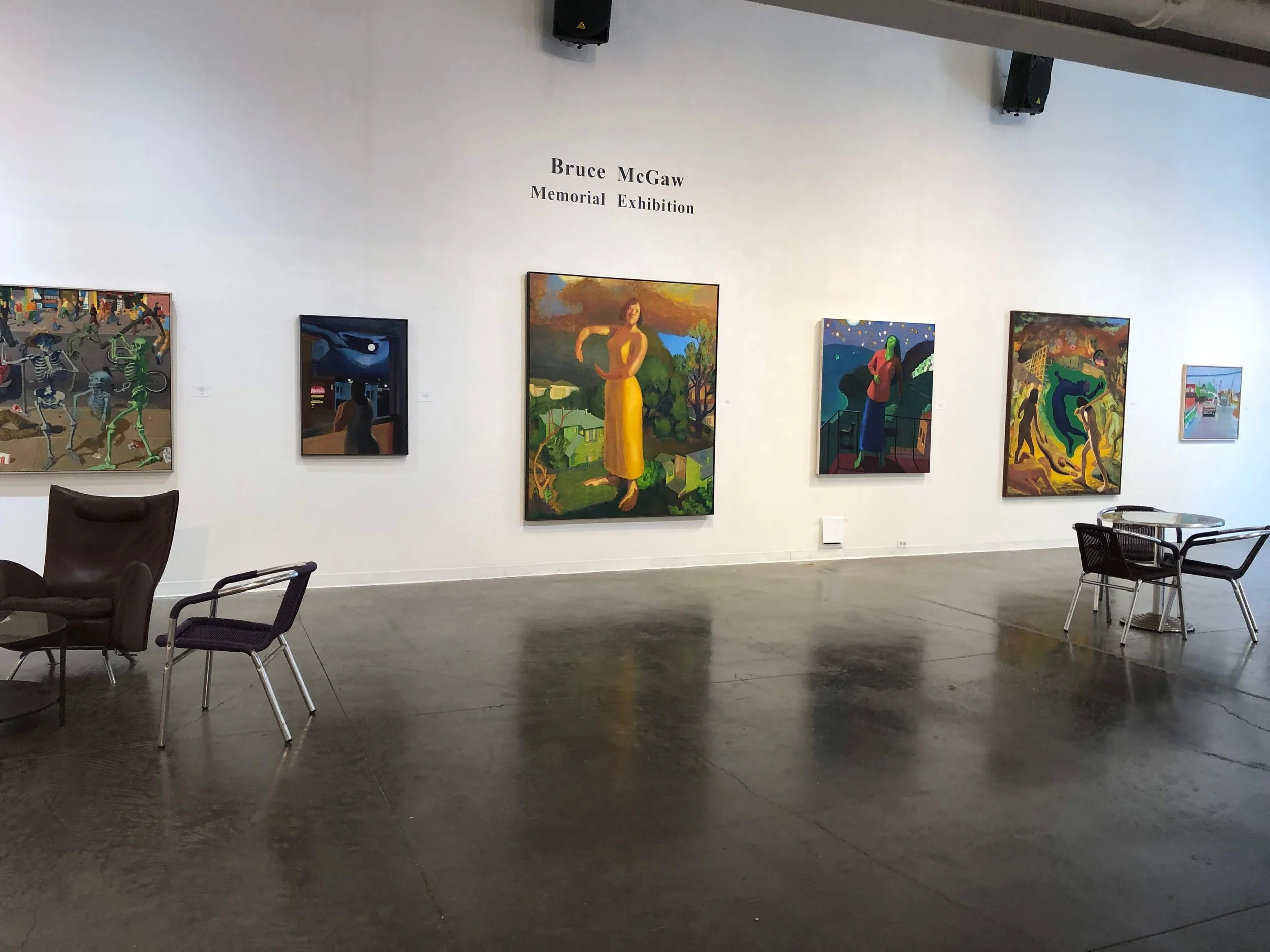Bruce McGaw, Memorial Exhibition, John Natsoulas Gallery
Shout / Whisper / Echo
By Jan Wurm
The walls of the John Natsoulas Gallery encircle with a ring of small paintings and, clustered in the center, three large gems. The complex imagery draws us into the space, only to demand a step back for distance and orientation.
This is a memorial exhibition for the artist, Bruce McGaw (1935 – 2025), a San Francisco Bay Area native who not only was the longest engaged instructor at the San Francisco Art Institute, but deeply rooted in the poetry and music of the Bay Area.
Unlike a museum retrospective of profound examination and exhaustive critical weight, a memorial exhibition may hold just a dozen works from a family member’s living room, a handful of gifts exchanged with fellow artists, or even just one painting nailed up for a month in a school library. In memorium is often the gentlest moment to be with an artist’s work and to allow the spirit to emerge and speak in a quieter tone.
Dedicating sixty years to teaching centers the importance of looking, reflecting, and absorbing. These core values imparted to his students held an undeniable influence on the work of McGaw himself. The 1957 Pink Face, rendered in broad brushstrokes of oil paint on paper, is anchored in the time Bay Area Figurative painting was asserting itself with the conviction of David Park, a seminal figure of immeasurable influence on generations to follow. This lineage does not require oblique tracing –it asserts itself and tethers McGaw to his teacher Richard Diebenkorn and from Diebenkorn to his teacher, Park.
Beyond the handling of paint, the integration of perspective and planar shift can be best appreciated in the dark thrill of Car (1956). Here the light slashes across the diagonal of the car bearing down with flashing speed in a panic-inducing night scene of illuminated unknown and mysterious threat.
McGraw’s contemporary visual culture in the Bay Area points to the deeper influences in his painting. To look further into the history the artist was examining is to see foundational structures and attitudes. The 1962 scene, Chairs, peers into a room, an art historical motif. Flanked by walls left and right, the deeper interior is framed by a pictorial device used by Diebenkorn, Matisse before him, Impressionists, and even earlier in Japanese prints. The empty chairs, evocative of meeting, conversation, passage and absence, hold the promise of an empty easel that beckons but remains silent.
But, sometimes a chair is not empty. Fish on Chair (1961) tilts the seat into a Cézanne tabletop, serves up an offering of fish that would have Braque drool, and even sets a coffee cup on Diebenkorn’s high horizon to reach to far corners. There is delight in play and dance across these blazing blue stripes of furniture radiating from a slathering of luscious cobalt green fish.
While artists often turn to self-portraiture in youth as exploration or assertion of self, late in life as a testament to old age or the ravages of illness, there are few historical figures who persisted in the close examination of their own visage as relentlessly as Rembrandt, Van Gogh, and Frida Kahlo.
Bruce McGaw Self Portrait 1965 Oil on canvas 42x22in.
This exhibition offers several self portraits by Bruce McGaw that engage less in portraiture than in investigations of painting itself. Fra Angelico, Picasso, Ben Shan – when painting can speak of generations of evolving vision, can hold centuries of notation and marking –it can lower the volume and whisper to the heart. This quiet storm scratches its way to the surface of Self Portrait (1965).
With two thirds of the head in shadow, an undated Self Portrait (circa 2000s), revels in light and dark, pattern and tone. McGaw may document his years in the greying of hair, but essentially it is paint and color and form that he portrayed.
Central to this gallery presentation are several large, composed narratives. Woman at a Window (1984) provides a lyrical insight into the poetry underlying Bruce McGaw’s visual landscapes. The figure of a woman bisects the picture: to her left a neon sign marks the street outside her window, to her right, the full moon bathes her and the glowing town. The dark swirl around the moon forms a visual rhyme with the woman’s hair, the moon a rhyme for her unseen face –only imagined as the viewer completes the evocation.
Street Scene With Skeletons (1992) presents social commentary of unrelenting disaster still relevant to life on our streets today. The violence can still hold a mirror to life decades later. The figures’ voice deep and raw, surfaces ready to release a scornful laugh.
Striking is another painting on the same wall: After Lorca. This green is a woman, dark in the night air, the edge of her body bathed in moonlight, back arched, her gaze to the star studded sky. The date: 2025.
For the many who knew the gruff manner of Bruce McGaw, the inverse was also clear: generosity and absolute dedication. McGaw has laid an entire universe before our feet. It is dark, at times difficult to decipher, close in tones verging on the ambiguous, and then, bathed with a glorious light like liquid gold to elevate and lift to the stars.
Through October 25, 2025 at John Natsoulas Gallery, 521 First Street, Davis, California 95616











